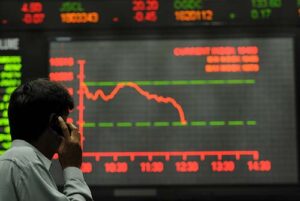The performance of the Pakistan Stock Exchange (PSX) has come under scrutiny, particularly the recent dismal run in the aftermath of the high returns post-Covid, with the benchmark KSE-100’s performance remaining lackluster since the beginning of FY22. The last two weeks of September have been awful, with the KSE-100 shedding 3.8 percent or 1,764 points. That said, in the broader context, the index decline is not as steep as when Covid hit, declining to the 27,228 level. While the Afghanistan situation played a part, the decline has recently been precipitated by other events, including;
1. Continued geopolitical tensions, particularly in the context of Pakistan’s relationship with the United States.
2. The change in monetary policy course with the State Bank of Pakistan (SBP) announcing a token 25-bps hike.
3. Pakistan’s impending IMF review and permutations on what the outcome may be and,
4. Roll-over, particularly with heavy outstanding leverage positions.
Since the beginning of July ’21, the KSE-100 has lost six percent, of which 3.8 percent loss came in just the last two weeks of September. The poor performance during FY22-to date came despite an expansive budget. Investors and the general public remained sceptical of the tenets of the budget being implemented, particularly instead of the upcoming IMF review. The same scepticism came to the fore as the Finance Minister announced a push back on duty cuts with regulatory duties on CBUs slated to increase to 50 percent, having been reduced to 15 percent in Budget ’22.
The government has made a hash of policy action as not just reversal of duty incentives to Auto and other industries were revealed, but also the much-vaunted Refinery Policy put into limbo with squabbling amongst different ministries. The confusion on policy action has severely dented investor sentiment at the PSX, with the Refinery sector amongst the first to be hit severely.
PSX performance has also been a consequence of scepticism surrounding the upcoming IMF review. While most market participants agree the IMF programme is likely to continue, given the respite from Covid, most view the demands particularly on the reform side (taxation, energy pass-through) to toughen significantly, thereby curtailing market enthusiasm. With IMF negotiations slated to continue till mid-October, we expect market performance to remain volatile in the coming days. Tariff increases on the electricity and gas front can and will impact a myriad of industries – the only question remaining is the quantum of increase.
A big question on the IMF programme is owing to the state of Pakistan’s relationship with the United States, particularly in the context of unfolding events in Afghanistan. Pakistan and the US have not seen eye-to-eye on Afghanistan, particularly under the Biden administration, despite Pakistan’s positive and globally lauded role in evacuations from Afghanistan following the Taliban takeover. Remember that very recently; the FATF added six further conditions for Pakistan’s entry into the white list, which surprised all and sundry. Despite crucial geopolitical events, the PM of Pakistan and the new President of the United States have yet to speak directly with one another – an event widely awaited. The cold shoulder and US inclination towards India have had some bearing on investor sentiment and confidence at the PSX.
The recent market meltdown seems to have been precipitated by the change in monetary policy course, despite the SBP increasing the policy rate by only 25bps. While a 25bps increase in itself is meaningless, given the low base of interest rates, the signal of the rate change is what has driven investor sentiment. In my view, the interest rate change is a subtle signal to the government to change its course on duty incentives towards imports, with the required impact being witnessed as the government has finally moved to curb imports. This in itself will be a two-pronged sword as import reduction is a natural cause of lower tax collection, with almost half of tax collection accounted for through import duties/customs etc. The GOP now faces the arduous task of decreasing the import bill on the one hand while increasing tax collection on the other.
Finally, the pressure created owing to the increase in interest rates direction, as well as the geopolitical situation and the IMF, created a perfect storm wherein roll-over week triggered a frenzy in the market. Leverage players, particularly those dealing in the Futures counter, faced margin calls, and thus, a domino effect on the lower side was created in the market. On Sep 17, the future position stood at a considerable 704.8 million shares outstanding in the September counter, worth PKR 25.8 billion. An increase in interest rates and some idiosyncratic stock-specific adverse developments led to a panic sell situation which resulted in consistent pressure at the stock exchange.

The dismal performance of the PSX has come at a time when our peer markets have continued to gain strength. Contrast Pakistan’s paltry 3.0 percent gain CYTD with that of Sri Lanka at 32 percent, Vietnam at 22 per cent, Thailand at 12.5 percent and India at 26 percent. Covid impacted all countries alike. However, Pakistan’s index performance has left much to be desired despite strong economic performance during the pandemic time. We believe the market’s lackluster performance is likely a consequence of geo-politics mixed with internal issues on the economic front. The government needs to come out with a concrete growth plan. Otherwise, gains made during the past year will be reversed. Performance on CAD and consequent pressure on the PKR as well as flip flops on policy matters (import policy, refinery policy, energy reforms) send out a wrong signal to the market. Uncertainty is the biggest market killer, and the government must act to make sure that it lays out a concrete economic plan.
With an undemanding P/E of less than 5.5x, where our peers trade in double digits, there is no reason for the PSX not to confirm. Earnings growth has continued to surprise us while our dividend yield is easily the highest in the region at 8 per cent +. Once the uncertainty settles, particularly on the IMF front, we will likely see a euphoric rise at the PSX. The government must, however, balance between reforms and inflationary pressures.
As mentioned above, the IMF and Refinery Policy will likely act as big triggers for the market. Uncertainty on both accounts has been killing performance. At the same time, global energy crises vis-à-vis the increasing prices of crude, coal, and LNG have created a difficult situation. We expect commodity price pressures to ease off sooner than later, where inviting valuations on Cement should be viewed as an accumulating opportunity. At the same time, with the recent pressure witnessed on the PKR and all indications pointing to an imminent rate increase in the US, investors should be eyeing US$ revenue-based sectors such as Textiles and Technology. For Textiles, outstanding export orders and recent cotton crop numbers are encouraging in terms of earnings outlook.
The world has really embraced Tech during the Covid phase, and Tech valuations have naturally gone through the roof. With funding of Tech ventures reaching an all-time high in Pakistan (new ventures have raised US$278mn CYTD), naturally, the listed Tech space, with a history of profitability and top-line growth, will see a spillover effect where we remain quite bullish. The change in our interest rate cycle lends credence to the likely performance of the Banking sector in the days ahead, while a continued uptrend in global crude prices will eventually unlock valuations within the Oil & Gas sector.
On a concluding note, some of the government institutions, particularly those sitting on billions of rupees, should take advantage of the attractive market valuations. However, equity valuations, although always rewarding in the long run, raise eyebrows for government agencies if prices fall. Hence, historically these government institutions have invested in government-owned listed shares. Given that these institutions do not have market investing expertise, NIT is usually the preferred vehicle for investment purposes. Deploying funds in the market through NIT should not be ruled out if the market does not pick up, as had been the case in 2008-09, when NIT supported the market through investment at throwaway prices, resulting in a significant gain to the institute as well as investors.

The writer is Chief Executive Officer at AKD Securities Ltd.

